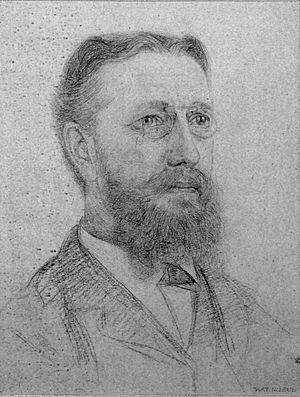Max Carl Wilhelm Weber facts for kids
Quick facts for kids
Max Carl Wilhelm Weber
|
|
|---|---|
 |
|
| Born | 5 December 1852 |
| Died | 7 February 1937 (aged 84) Eerbeek, Netherlands
|
| Nationality | German Dutch |
| Known for | Weber's Line |
| Spouse(s) | Anna Weber-van Bosse |
| Awards | Foreign Member of the Royal Society |
| Scientific career | |
| Institutions | University of Utrecht, University of Amsterdam, University of Bonn, Humboldt University |
| Author abbrev. (zoology) | Weber |
Max Carl Wilhelm Weber (born December 5, 1852, died February 7, 1937) was an important scientist from Germany and the Netherlands. He was a zoologist, which means he studied animals. He was also a biogeographer, meaning he studied where different animals and plants live around the world.
Contents
Becoming a Scientist
Max Weber started his studies at the University of Bonn. Later, he went to the Humboldt University in Berlin. There, he worked with another famous zoologist, Eduard Carl von Martens. Max Weber earned his doctorate degree in 1877.
After finishing his studies, Weber taught at the University of Utrecht. He even went on an exciting trip to the Barents Sea to explore. In 1883, he became a Professor at the University of Amsterdam. He taught about zoology, anatomy (how bodies are built), and physiology (how bodies work). In the same year, he also became a Dutch citizen.
Discovering Weber's Line
One of Max Weber's most famous achievements was leading the Siboga Expedition. This was a big journey to explore the waters around Indonesia. During this expedition, he made many important discoveries.
His findings led him to suggest something called Weber's Line. This is an imaginary line that helps explain where certain animals live. It marks a boundary where the animals, especially mammals, are mostly found in Australasia. This region includes places like Australia and New Guinea.
Weber's Line was an alternative to another famous line called Wallace's Line. Scientists found that for many animals, Weber's Line was a better way to show the difference between animals from Asia and animals from Australasia. For example, the Tanimbar Islands seemed to be a more important dividing line for mammals than the one between Bali and Lombok.
Naming Land and Sea Features
Max Weber also worked with another scientist, G.A.F. Molengraaff. In 1919, they gave names to two important underwater land areas: the Sahul Shelf and the Sunda Shelf. These are like underwater platforms that connect islands.
Honors and Legacy
In 1887, Max Weber became a member of the Royal Netherlands Academy of Arts and Sciences. This is a very respected group of scientists.
Many animals have been named after him to honor his work. These include three types of reptiles:
- Anomochilus weberi
- Hydrosaurus weberi
- Pachydactylus weberi
Two types of mammals are also named after him:
- Prosciurillus weberi (a type of squirrel)
- Myotis weberi (a type of bat)
Even a very deep part of the ocean is named in his honor! The Weber Deep is located in the Banda Sea. It is incredibly deep, reaching about 7,351 meters (or 24,117 feet).
See also
- Anna Weber-van Bosse
- Mattheus Marinus Schepman
Images for kids






